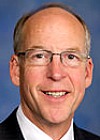U.S. Rep. Greg Walden (R-Hood River) spoke at a House Energy and Commerce joint subcommittee hearing on Tuesday, urging reforms to federal rules and laws in order to protect forests from devastating fires.

“When we last held a hearing on this topic in September 2018, my home state of Oregon for the second year in a row was battling near record wildfires,” said Walden. “Communities in my district experienced some of the worst air quality in the world, while also suffering significant economic impact as tourists went elsewhere. Oregonians told me that those with breathing disorders actually had to leave the state, go over to the Oregon Coast, go somewhere else to find air that they could breathe.”
In the wake of 2018’s devastating fire season, Oregon and California took steps to adopt new strategies for responding to forest fires, including coordination with utility companies to turn off power to high risk areas in order to prevent fires caused by downed power lines.
“My hometown, serviced by PacifiCorp, was told this year we would be in that zone — if there was a problem they would de-energize our entire town,” said Walden. “This past year we witnessed how this risk reduction practice put two million people in the dark just as windstorms were threatening new wildfires. But we also know this strategy is not without negative consequences for people who have special medical needs that require electricity without interruption.”
Walden noted that unwieldy government regulations are standing in the way of other common-sense risk reduction strategies, including hazard tree removal and improvements to the aging power-grid.
One of the witnesses at the hearing was Dave Markham of Central Electric Cooperative in Redmond. Central Electric’s service territory is 56 percent on federal land. Walden shared a photo that Dave Markham had given him that showcased an aged power pole that Central Electric attempted to move 20 feet in April so that they could mitigate against the threat of wildfire. However, the Forest Service did not get around to that application until October. Unfortunately, October was too late to get in and do the work to move one pole before the snow.
“This is why we’ve got to reform the federal rules and laws that prevent the utilities from doing what they know needs to be done to protect our great National Forests and the communities around them,” said Walden. “Delays in these sorts of maintenance efforts can have deadly consequences, especially when combined with our poorly managed federal forests, that frankly, are overstocked and waiting to burn.”
He further emphasized previous evidence from OSU forestry professor John Bailey, who testified before the committee in 2018 that the natural density of tree stands in eastern Oregon is around 20 trees per acre. Mismanagement has pushed that number to upwards of 1,000 trees per acre.
“When fire strikes, that excess ends up as smoke and carbon in our atmosphere” said Walden. “We know that the Forest Service and the EPA have data that in 2015 in Oregon we burned 685,000 acres, that emitted the equivalent annual emissions of 3 million cars, or 3.5 coal fired plants. Nationwide since 2015, we’ve burned 39 million acres. Following the same pattern that would be emissions roughly equal to 170 million cars or nearly 200 power plants.
“We need to do more active management. We have legislation to do that.”








